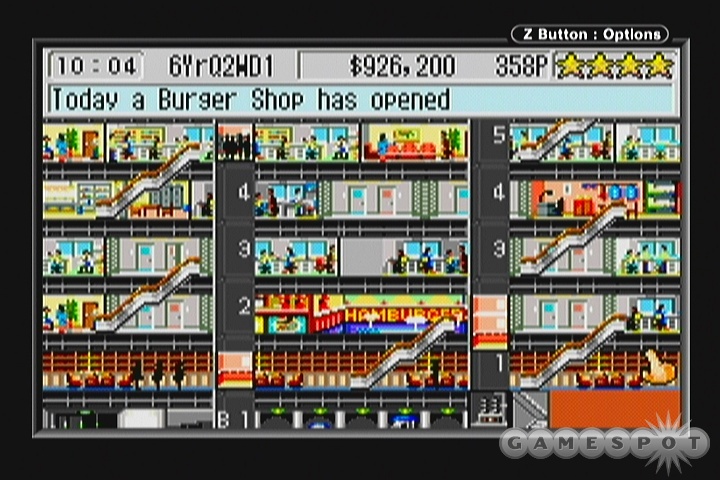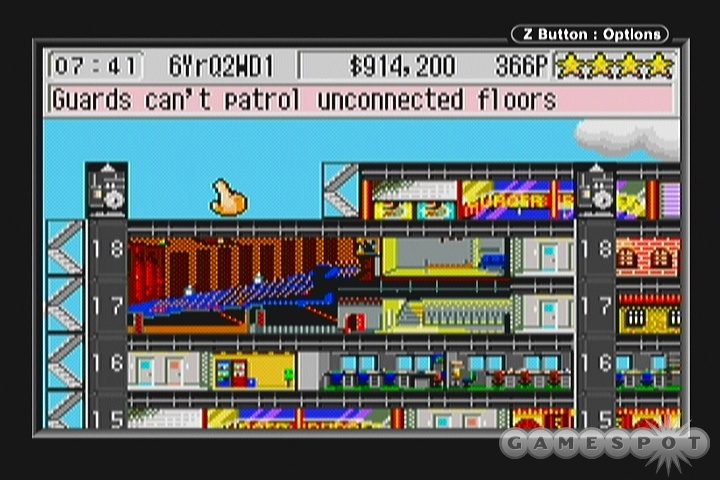Ron Popeil's slogan for his Showtime Rotisserie Grill is "set it and forget it." That's also an appropriate way to describe The Tower SP, Sega's skyscraper management simulator for the Game Boy Advance. There's plenty to do early in your building's life, what with installing elevators, leasing out offices, opening food courts, and hiring staff to upkeep the premises, but once you've put together a working layout, you'll find yourself literally watching the game play itself.

The Tower SP is basically SimCity in an office-building setting. In fact, the game was previously titled SimTower when it was released on the PC platform more than a decade ago. The office spaces and elevators in The Tower SP are analogous to the plots of land and highways in SimCity. Instead of building the largest city possible, however, here you're trying to build the tallest building possible and fill it with tenants.
For the first three hours or so, the game is fairly hands-on. You can bring tenants into the building by leasing offices, selling condos, and renting out hotel rooms. In turn, the needs of tenants and guests have to be tended to, which means installing bathrooms, hiring housekeepers and security staff, and opening various restaurants and shops. Following suit, those housekeepers and security guards will keep cockroaches and thieves out of the building, while those restaurants and shops will attract revenue-bearing shoppers into the building. Also, you'll have to manage traffic throughout the building by installing elevators, parking areas, and subway ramps. It's all tied together really well, and for those first three hours or so, you'll enjoy the groove that develops as you earn money one day and redirect it toward additional upgrades the next, gradually watching your custom skyscraper grow ever taller.
Despite putting numerous menu choices and informational screens at the player's fingertips, the game's controls aren't all that complicated. That's a pleasant surprise considering the game's PC-based ancestry. In the PC game, players used the mouse and keyboard to move the pointer and make selections. In the GBA game, you use the directional pad to move the pointer, the R button to bring up menus, the select button to bring up informational screens, and the A and B buttons to make or cancel selections. The GBA's so-called lack of buttons isn't an issue. If anything, the GBA game offers more interaction than the PC game did, because players can now mash buttons to lure customers into shops faster and to clean bathrooms when housekeeping has the day off.
So long as you hire enough housekeepers and security staff, the building will run itself. That's not a bad thing early on, when you're still gradually buying and laying out the offices, shops, and elevators that will eventually pull in big money for you on a regular basis. It does become a problem after about three hours though, once you've put together a layout that's regularly bringing in half a million dollars or more a week. From that point, you can just put the game down and let it play itself until you've stocked away enough money to purchase all of the expensive movie theaters, subway stations, and giant elevators you'll need to earn your building its four-star rating and "tower" status.

It also doesn't help that the game's presentation is about as barebones as it gets. Visually, the 2D graphics are crisp and get the job done, but the colors are ugly, and there's no depth to the building or its occupants. Every office and storefront is rectangular, and the people are tiny stick figures. Fine detail is tough to make out, so much so that it's impossible to discern individual shops and restaurants. Thankfully, that isn't required for gameplay. Some of the animated details are nice, particularly the people that mill around and interact with the various doors and shop counters in the environment. Audio is nothing special, just a collection of footsteps, phone ringers, and elevator noises meant to mimic what you'd hear if you were standing in an actual office building.
Diehard fans of the sim genre will probably want to take a pass on The Tower SP, since it doesn't provide much in the way of staying power. If you're a casual sim fan, however, and intend to play the game primarily in short bursts, you may still want to give it a try.